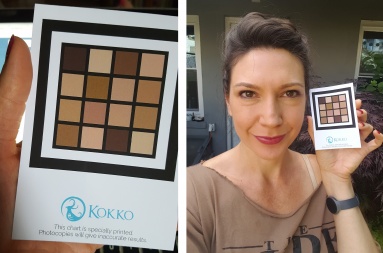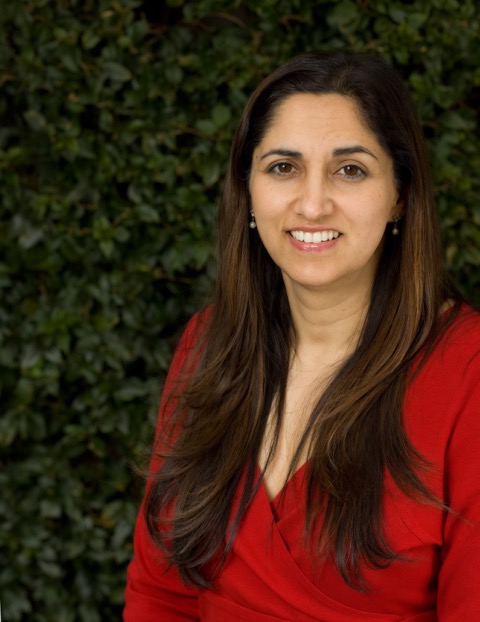Thanks to Nina Bhatti, I found my perfect foundation. The founder of Kokko—an app that promises to find you a foundation that actually matches your skin—has the kind of background that makes her current project seem almost inevitable: She’s the former chief scientist of the mobile color research group at Hewlett-Packard, a former senior technologist for Nokia, and a woman who has wanted to have good makeup at her disposal without reading women’s magazines like a part-time job. Her creation is deceptively simple: You download the Kokko app, then take a selfie alongside Kokko’s color chart, which is the analog bit that makes this digital tool so excellent: By measuring your skin color alongside the known quantity of the color chart, Kokko has more to work with than less precise makeup matching apps, meaning you’ll wind up with one foundation that’s just right instead of six that are almostright. They’re actually giving The Beheld readers the chart for free until July 11; go here and use the code AUTUMN (heh! I’m a mononym!), and you’ll just pay $1.30 for shipping.
I spoke with Nina about the technical aspects of color matching, why there’s no Seamless for makeup (yet), and why she refused to learn to type. In her own words:
On Color
You know how some people have perfect pitch? There are so few in the human system who have perfect color, but we all have that friend who has that eye for color—those people who are like, “You need more blue in that red, it looks better with your skin,” while the rest of us are like, “It just looks red!” I wanted people to have that friend there with them, whispering in their ear. Color is incredibly complex. It’s perceptual—the color you put next to it will make that color appear differently, that’s how your brain works—and it’s also about what is going on physically in your eye. Then you’ve got the quality of the light that’s on any given color. It’s so complicated, and yet so much of aesthetics is about color.
The only people who really have that depth of understanding about color are color scientists. The way that they measure color is by using these very scientific, controlled devices to measure color. They have a specific light that shines on an object, they have a specific angle, a specific amount of diffuseness in the light. They’d measure the reflectance at every wavelength, the specific receiver technology. It’s this really technical way of measuring color. That’s all well and good, but I’m thinking about new users who aren’t going to drive around with this scientific instrument. What could they do? Well, these days the mobile devices with cameras are the vehicle of choice, so let’s use that. The color scientists didn’t actually like the research when I started it. Their own work is measured on these incredibly accurate measures—sort of like, 10 decimal places of accuracy. It’s important for paint companies, but that’s not the degree of accuracy we needed. I said, “Okay, I don’t have to be perfect the way you guys are, because if there’re only a certain number of shades of foundation, I only need to just pick the one.” People who know about color didn’t ever want to do approximate color matching because it just violates their sensibility. They’re not thinking about its application domain. I came at it from a very strong belief in the consumer problem.

The Kokko ColorChart: By giving the camera a known color quantity that's photographed alongside the user's face, the chart lets the app be more precise than it would just by the camera alone.
The whole idea of using the color chart is something that was used in the very early Technicolor movies. When you develop film you can affect the final colors by adjusting the developing chemicals —so what’s the right color? Technicolor’s color supervisor, Natalie Kalmus, came up with a calibration. They developed this chart that they called a lily, and they’d hold up that up front of the camera and would use that to find the correct, consistent color. She actually figured that out. She’s the one who actually developed Technicolor color accuracy. So you have that kind of process, and you have the process where you go to a makeup artist and they look at your skin and characterize what product is going to work. I took the manual process and tried to automate it. So once we get your skin color correct, we find what product to put on that. We used an expert system to determine how makeup artists would characterize lots and lots of women—we actually had women come in and had makeup artists match foundation to their skin—and then used that data to figure out what the unknown woman would like. It’s perfect for computer and imaging science because that’s what they do—have lots of data and then figure out what the signal is.
On Silicon Valley and Sexism
I refused to take typing in high school. It might have been helpful to me, but I never wanted any job that required knowledge of typing. In those days typing was a gateway to low paying female-dominated professions. I wanted to set my own path and not be bound by society’s definition of female professions. My family expected the girls to do as well as the boys so that was never an issue.
When I was working in computing in the ’90s, there was this weird line you had to walk as a woman. If you cared about your hair and makeup, they didn’t think you were a good engineer. If you didn’t care about your appearance, then you were accepted as technical. It’s different as a corporate manager—there are a lot of women there—but in the engineering ranks it was different. I became one of those technical people who did a lot of customer conversations, because I did clean up well and I could talk to them. But then some of the junior ones would be like, “Can you really program?” It’s not that they think you can’t, it’s that you’re an early example of what a great engineer that also cares about appearance can look like. Being able to look good and be technically strong—there’s a bias there that I can’t explain. I mean, more women go to medical school than men! You can overcome that bias, because you’ll realize, “Wow, that person is really good,” but it takes some cognitive time.
I’m pitching this technology to largely men, and they don’t understand the beauty market. I’ll send an email stating, “We’re solving this makeup problem” and they’re like, “There’s a problem?” One investor said, “I didn’t know [foundation matching] was a problem but I talked to a family member and she said, ‘Yes, I need this—this is huge.’” He was stunned. And that’s an opportunity, that this is unrecognized. There are 101 startups to get dinner to your door—ingredients to your door that you cook, meals to your door that somebody else cooked for you—and nobody has a problem understanding that. With color, women’s eyes light up and get excited about it, but the men who are typically making capital investment decisions aren’t aware.
I don’t think that it’s sexist. There’s a rational reason for them to be wary—there’s a discomfort because they’re not the target market. It’s not that they hate women and don’t want women to have good things—they know $150 billion worldwide is being spent on this stuff. The question for them is, Do I understand this market? Do I have an intuition for it that lets me feel comfortable investing? This is where we want to differentiate between sexism and non-familiarity. These guys are happy to make money—but when you have no intuition for the market, it’s much harder for them to put money in at the earlier stages when there’s very little evidence. That’s not intentional sexism. That’s a current that you have to swim against. This is why people say they want more women in tech in the product design area, but you have places where there’s never been one woman on the team.
On The Right to Beauty
Women are expected to be born with this aesthetic ability—the clothing, the makeup. They’re just supposed to know. I sense a lot of frustration, because a lot of women feel like, I don’t actually know. The makeup buying process has become intimidating unless you study it—which some women do, these mavens who just revel in it and are good at it and get it, which is wonderful. But many of us just want someone to say, “This is going to look great on you,” and trust them. Because women know when everything’s right—you just feel good, you stand a little taller, you walk a little zippier. They know the feeling of feeling good, and they know the feeling of feeling awkward. Color is an important aspect of looking and feeling good, and we’re trying to solve that problem, that awkwardness of not being sure if you’re doing it right.
I don’t see why every woman shouldn’t feel wonderful about herself. Every woman has a legitimate right to beauty. This is technologically enabling that right. Sometimes people might be trying to do makeup but they don’t have that skill, so they might go overboard, and that can be devastating. And there are times in a business setting when you just want to look really pulled together and polished, and makeup can be a part of that setting. That’s different from feeling like, “Oh my god, I have to get out of bed 30 minutes before my husband so I can put my face on.” It’s scary to feel like you can’t be seen as who you are, and I don’t want to live in a world where I have to wear makeup every day and can’t be seen as my natural self. But this is about enabling people who might not have those makeup skills. I’d like women to have that in their toolkit.
